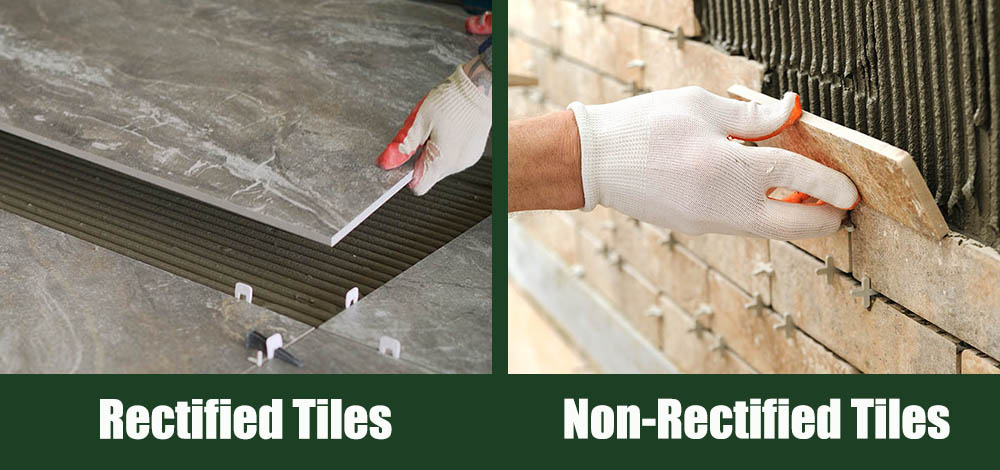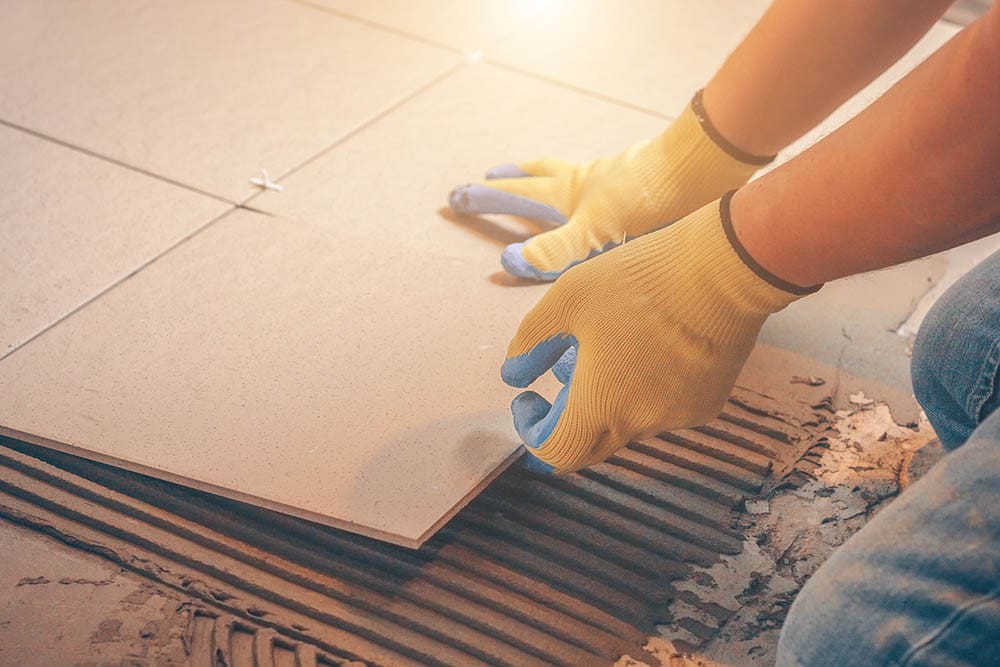What Is a Rectified Tile? Pros, Cons, & FAQ
-
- Last updated:

Rectified tiles undergo edge treatment to create straight and precise edges. Tile rectification involves grinding or sawing the tile edges to “rectify” each piece into an accurate dimension. These tiles are of a uniform shape and size, and if properly installed, they will give your spaces sleek, clean aesthetics.
You can use rectified tiles on just about any area where you can install regular tiles, like your flooring, entryway, Kitchen backsplash, bathroom vanity, and more. Because the tiles are twelve inches or larger and are perfectly uniform, they only require fine grout lines less than 1/8 inch.
However, installing rectified tiles instead of their non-rectified counterparts during a remodeling project can easily overstretch your budget. Before making a significant financial investment, here is a detailed overview to help determine whether rectified tiles are right for your home.

What Are Rectified Tiles?

If you are looking for a flooring option that provides a uniform, seamless look with less grout, one of the popular alternatives to consider is rectified tiles.
These are porcelain or ceramic tiles with precisely machined edges. Their mechanical finish also gives them a polished appearance and a fine bevel on their top edges to lower the risk of edge chipping.
Rectified tiles are pretty much like regular pressed tiles. The main difference is that they undergo an additional process after being fired in a kiln. The rectification process gives them perfectly straight edges and precise dimensions for a clean, symmetrical look after installs.

How Are Rectified Tiles Made?
A lot has changed in the processes of manufacturing tiles. Even with advanced technology, producing ceramic or porcelain tiles with precise dimensions is still challenging.
As the tiles are baked or fired in a kiln, they shrink, expand or warp, creating minor variations in their overall sizes. The molds used to make rectified tiles are typically bigger to account for possible shrinkage when placed in a kiln.
Rectified tiles undergo a “rectification” process to mechanically ground down and polish each tile into a uniform length and width. This makes the tiles identical in size and gives them sharp, clean edges.
The machines that cut rectified tiles work with fine tolerance to make the tiles as identical as possible. However, the rectification process does not address the thickness of tiles. It is still possible for rectified tiles to have slight thickness variations that could hinder a perfectly flush look after installs.
Rectified Tile Cost
Rectified tiles cost more than non-rectified tiles of a similar type and quality. The additional production process justifies the higher figures on the price tag. That said, the average cost of the tiles per square foot ranges between $1 and $20.
Another expense to keep in mind is the cost of installation. Hiring a contractor with unrivaled skill and experience in laying rectified tiles is crucial. While less grout and faster installs because of the larger tiles can keep costs in check, installation fees can be as high as $20 per square foot because of the skill level required.
Rectified vs Non-Rectified Tiles

Rectified tiles are also known as sharp edge tiles or dimensionally stable tiles. On the other hand, non-rectified tiles are commonly referred to as pillow-edged, cushion-edged, or soft-edged tiles. These terms describe some of the critical differences between rectified and non-rectified tiles.
Generally, non-rectified tiles have slight differences in length and width. Their installation requires thicker grout lines to account for these differences. While rectified tiles are not immune to lippage caused by potential differences in their thickness, they have sharp 90-degree edges and uniform dimensions. This allows installation with thinner grout lines for a cleaner final look.
Whether to opt for rectified tiles to make your floors appear like one large tiled area or to stick with traditional non-rectified tiles will depend on your preference. Neither is better than the other; the only difference is that rectified tiles can give your spaces modern aesthetics and a seamless finish.
Advantages of Using Rectified Tiles
Non-rectified tiles have the main disadvantage of having larger grout lines. Over time, the dirt and staining on these grout lines will be more apparent, and even a good scrub will not always make them as good as new.
- Perfect dimensions for a seamless final look
- Thin grout lines for easier cleaning
- Straight edges will give your home a modern look
- Large tiles make installation easier
Rectified tiles address the concern because they are the same size and have sharp 90-degree edges. They can be laid close together, and the consistency in their sizing makes large grout lines unnecessary. Rectified tiles can give your spaces an element of luxury with their seamless look.

Disadvantages of Using Rectified Tiles
On the downside, the additional process of rectifying the size differences in the fired tiles will cost you a little more. You also have to use unsanded grout to create thinner grout joints. Compared to sanded grout, unsanded grout breaks down faster.
- More costly than non-rectified tiles
- Requires more skill during installs
- Any lippage will be more apparent

FAQS
Here are some frequently asked questions about rectified tiles.
What Is the Recommended Size of Rectified Tiles Grout Lines?
Rectified tiles have a uniform size and precise 90-degree corners. They require the least amount of grout compared to non-rectified tiles. While regular chiseled or punched tiles need larger grout lines of up to 3/16 inches, the grout lines for rectified tiles should be no more than an ⅛ of an inch.
Rectified Porcelain vs Ceramic Tiles: Which Is Better?
Porcelain and ceramic tiles differ mainly in their manufacturing process. Rectified tiles made from both materials are of good quality, although porcelain tiles are made from more refined clay and fired at higher temperatures. They are denser and longer-lasting than ceramic tiles, which also makes them more expensive. Your budget should help you decide the better option for your project.
What Is Lippage When Laying Rectified Tiles?
The rectification process does not involve making the thickness of tiles identical. Any differences in the thickness of two adjacent tiles can cause lippage, meaning they will be completely flat on the surface. Even though lippage is more apparent with rectified tiles because of the thin grout lines, skilled contractors have proven tricks to achieve the intended finished look.

Final Thoughts
Rectified tiles can complement the aesthetics of your modern home with their clean, seamless finish. They are a popular option for those looking to give their residential or commercial interiors the fantastic effect of perfectly symmetrical flooring.
Work with a skilled tile installer to get the best out of your investment. The installation process requires unrivaled precision when leveling the substrate and when laying the tiles. When done right, tile installation projects using rectified tiles always have breathtaking results.
Featured Image Credit: DUO Studio, Shutterstock
Contents


